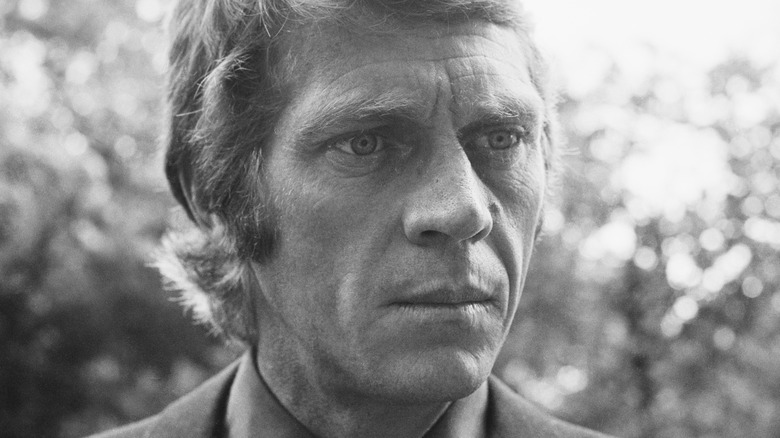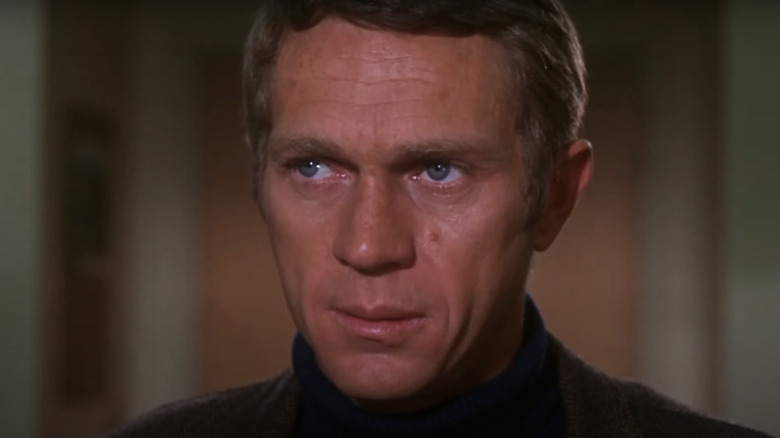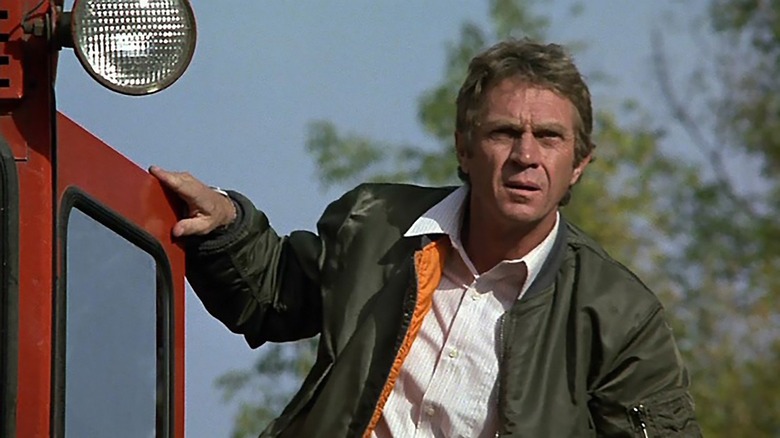The Special Effect Substance That Is Linked To Steve McQueen's Death
Before Steve McQueen became an iconoclastic Hollywood legend and "The King of Cool," he had an unusual upbringing, as described in Far Out Magazine. His stunt-pilot father left him and his mother when he was still a baby, and because she wasn't able to take care of him, McQueen lived with his grandparents for a time, then with his great-uncle Claude, before finally returning to his mother after she married again. Steve was a rambunctious child, so when he and his parents moved to Los Angeles, he was placed in reform school. Upon leaving school, McQueen drifted around before he enlisted in the Marines. He was far from a model soldier and often got into trouble, but he was ultimately honorably discharged in 1950.
Far Out Magazine states that McQueen was influenced by his aspiring actress girlfriend at the time when he picked up acting in New York at Sanford Meisner's Neighborhood Playhouse, and it wasn't long before he started doing theater in roles that gradually got bigger and bigger. He eventually moved to California to make the leap from stage to screen, and he made his first big splash as the lead in the classic 1958 sci-fi horror film, "The Blob." McQueen capitalized on this success with the top role as bounty hunter Josh Randall in the western TV show "Wanted: Dead or Alive," and from then on his persona as a charismatic antihero was solidified, which can be seen in such films as "The Great Escape," "Bullitt," and "The Towering Inferno."
Steve McQueen's health decline and asbestos
According to Mesothelioma.com, in 1978, two years before his untimely death, McQueen developed a constant cough, and it wasn't until December of 1979 that he was diagnosed with pleural mesothelioma, a disease that is most often linked to exposure to asbestos. Because the symptoms of mesothelioma can occur decades after exposure, it can be hard to determine when exactly one contracted this form of cancer. During the time that McQueen was in the Marines, servicemen were at great risk of asbestos exposure on ships as the material was widely used in that era.
However, there's also the possibility that McQueen's death is linked to asbestos from his time as an actor. The dangerous substance was used in Hollywood, primarily for special effects, as its fire-resistant qualities made it useful as fake snow and for fire-related stunts. Being a lifelong lover of cars and motorcycles, McQueen wore a flame-retardant suit when doing stunts or racing in his spare time; many of these suits at the time were made from asbestos, which meant that he was exposed to the substance both on and off the set for many years. Because we're now more aware of the harmful effects of asbestos, Hollywood has drastically reduced its use in filmmaking.
Steve McQueen's death
As described by Mesothelioma.com, by the time Steve McQueen had been diagnosed with pleural mesothelioma, it had advanced so quickly that he was told by American doctors that his tumors were incurable. Because radiation and chemotherapy did little to help shrink the tumors, McQueen turned to Dr. William Kelly, who practiced a form of Gerson Therapy, an alternative treatment whose effects on cancer are still disputed, per Healthline. McQueen wanted to keep news of his illness private and only told close friends and family, but word still leaked to the public.
While McQueen seemed to show some signs of recovery, he soon died from cardiac arrest on November 7, 1980, in Ciudad Juárez, Mexico when he was only 50 years old. The final film that he shot before his tragic death was 1980's "The Hunter," based on the story of real-life bounty hunter Ralph "Papa" Thorson. McQueen left behind a cinematic legacy of coolness that has yet to be surpassed.


